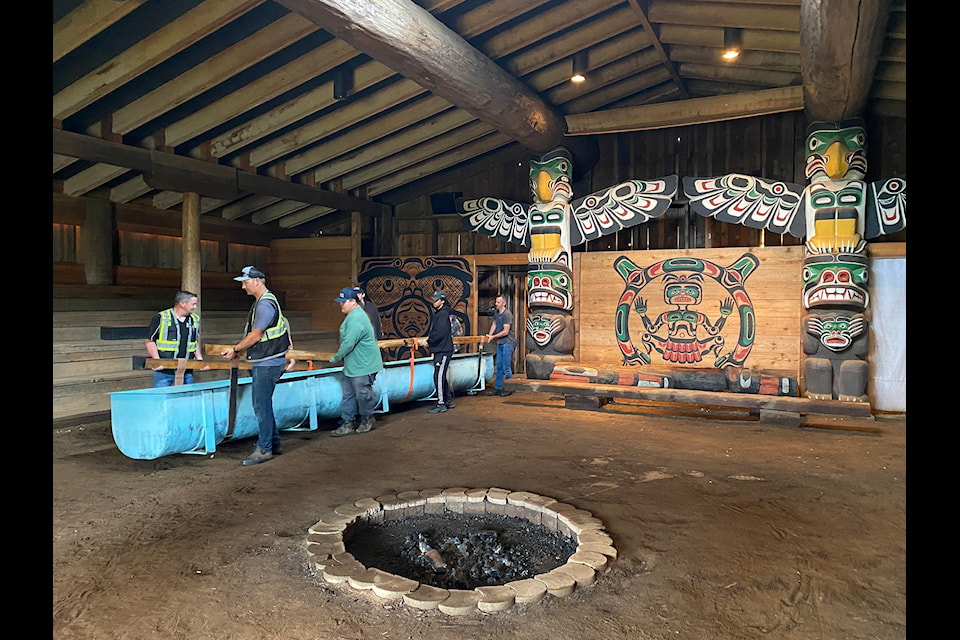One of the largest and most complete examples of Pentlatch ingenuity is on display at Vancouver Island University's Deep Bay Marine Field Station.
The significant cultural belonging was unearthed by the K’ómoks First Nation and archaeological collaborators and is on public display at the field station in Bowser for the next six months.
"At 550 years old, the fish trap panel is an incredible and enduring example of Pentlatch cultural ingenuity," a release from VIU says. "It is the largest and most complete of its kind on the Northwest Coast, and potentially in the world. It measures roughly six metres long and 70 cm wide, with 13 long laths and nine vertical support laths, bound together with cordage made from plant fibres."
The panel was built by the Pentlatch Ancestors of th K’ómoks and Qualicum First Nations. It was one of 78 panels that would be used in a single-winged chevron shape to trap and catch salmon.
“The fish trap panel is an incredible example of our Ancestors’ technological sophistication and ingenuity. It represents the strength of our cultures, and it continues to be a point of pride for our Nation," said Candace Newman, Elected Councillor for K’ómoks First Nation. “Preserving the panel has been a massive collaborative effort since 2017 between K’ómoks members, Guardians, archaeologists, Royal BC Museum Archaeologists and Conservators, and now the Deep Bay Marine Field Station. Many community partners have volunteered their time and resources to help document, preserve and safeguard the panel."
In 2017, this particular panel was revealed by shifting sediment in the K’ómoks Harbour, on the beach in front of K’ómoks Reserve #1. The K’ómoks Guardians, community members and archaeologists moved quickly to preserve the panel, knowing that exposure to air could cause it to deteriorate. However, K’ómoks First Nation Culture and Language Manager Pamela Mitchell says that the fish traps were not "discovered" by archaeologists.
"K’ómoks Elders have always known about them," she said. "In 1936, my Säsitla ancestor George Mitchell talked about the Pentlatch ‘fish mazes’ in an interview with an ethnographer. He said the traps were owned and maintained by specific families, who had priority access to fish. As a kid growing up in the ’80s and ’90s, my dad would tell us not to touch the fish weirs, because they had been there for a long time.”
Dr. Lia Tarle, a K’ómoks First Nation Archaeologist said that the fish traps were built perpendicularly to the shore, with a "leader" line to direct fish into the enclosures during high tide, where they would be trapped as the tide went out. Panels like this one would be used like fences and could be removed to allow some fish to escape if too many were trapped for a sustainable harvest.
“The long laths were made from Western Hemlock and the short laths were made from Sitka Spruce. The cordage was made from roots or small tree limbs (withies)," she said. “We’ve been collaborating with archaeologists, the Royal BC Museum, and community partners like ̨��MM������ Transportation Solutions to preserve and move the panel, which is an elaborate and delicate process. KFN is taking the lead in documenting and preserving their cultural heritage, and we’ve recently extended the oldest radiocarbon date of the fish trap stakes in the harbour from 1,350 to 1,450 years ago (the year 500).”
Qualicum First Nation Elected Chief Michael Recalma said that the panel shows how connected the two Nations are.
"We’re tied in so many ways," he said. "The land is shared, it always has been, always will be. In Deep Bay, we also have stone traps that are close to this facility, and they are thousands of years old. Again, it shows a different way of fishing and how innovative we were to utilize nature and use the resources we had to trap the fish we needed.”
The Deep Bay Marine Field Station is located at 370 Crome Point Rd. in Bowser.



